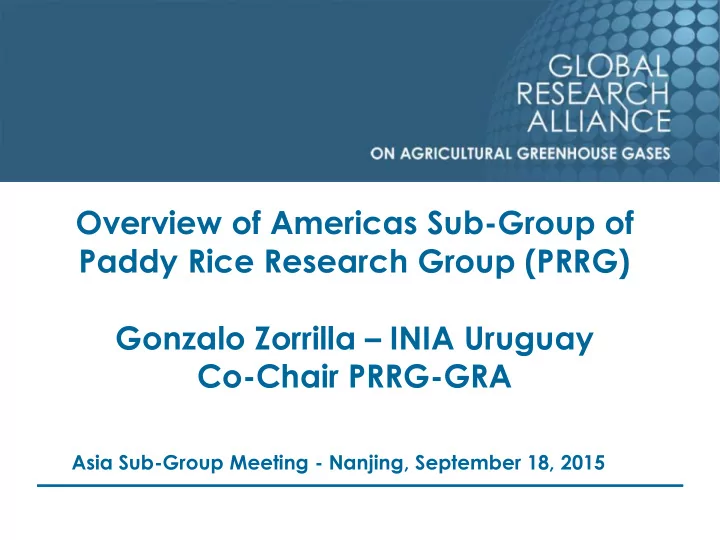

Overview of Americas Sub-Group of Paddy Rice Research Group (PRRG) Gonzalo Zorrilla – INIA Uruguay Co-Chair PRRG-GRA Asia Sub-Group Meeting - Nanjing, September 18, 2015
Rice is everywhere in the Americas
Rice is everywhere in the Americas Less than 40% irrigated – more than 70% of total production
Paddy Rice Members • 27 countries are members of the paddy rice group • 9 countries in Asia • 12 countries in NS America • 5 countries in Europe • 1 country in Africa
Members in the Americas • USA • Bolivia • México • Chile • Nicaragua • Paraguay • Colombia • Brasil • Ecuador • Argentina • Perú • Uruguay Not members with important irrigated rice areas: Venezuela, Guyana, Cuba, Dominican Republic • Europe? Spain, Italy •
Partners • CIAT – International Center for Tropical Agriculture • PROCISUR – Southern Cone NARS Consortium • CCAFS – CGIAR Climate Change, Agriculture and Food Security Program • CCAC – Climate and Clean Air Coalition on Short-lived Pollutants
1 st . America Sub-Group Meeting May 2014, CIAT, Colombia Attended by 9 Alliance member countries and 3 partner institutions.
2 nd . America Sub-Group Meeting February 2015, Pelotas, RS - Brazil Alongside the XII Latin American and The Caribbean International Rice Conference 2015 Attended by 6 Alliance member countries and 3 partner institutions.
GHG Emissions Research in South America
Extensive rice cultivation
Direct seeding and initial applications in dry s
Mechanized systems
An example of Improved Intensive Rotation Summer Tillage RICE Ryegrass Ryegrass No-Till No-Till 5 Years All rotation phases present RICE Ryegrass Summer Tillage Grass & Legumes (2 years)
AWD is being tested in several countries
AWD Brazil T. Zschornack - UFRGS Significant reductions in CH4 emissions and no yield penalty
AWD Uruguay S. Tarlera, P. Irizarri , A. Roel – UDELAR, INIA Scaled GWP down from 0,58 to 0,31 kg of CO2 eq/kg of rice (47%) 10 % yield penalty
AWD Colombia Colombia, Vietnam and Bangladesh
AWD Colombia
Other approaches for reducing GHG emissions from paddies
Some Findings • Rotations with other crops reduce emissions and increase land productivity • Anticipated tillage (not in winter) reduces emissions and ensure good seed bed • No-till systems reduce emissions compared with conventional tillage, and they have several other advantages to farmers
New Project in Uruguay
Project Goals • Comparison of three contrasting rice systems regarding intensity of annual CH4 and N20 emissions and productivity (low-medium-high rice intensity) • Evaluation of soil microbial groups involved in C and N recycling relevant to methane and nitrous oxide emissions • Correlation between biological and physico- chemical parameters with regard of GHG emissions in the three different systems
Paddy Rice Research Group • Co-chairs Kazuyuki Yagi, NIAES, Japan Gonzalo Zorrilla, INIA, Uruguay • Action plan: 1. Standardize measurement techniques 2. Database of experimental sites 3. Increase country participation 4. Pilot multi-country experiment 5. Network for mitigation and adaptation synergies
Standardization America Sub- Group will start reviewing the guidelines and proposing additions or complementary information if needed
Database A new proposal to develop a database (DB) of experimental sites was endorsed. Spreadsheets for data input were circulated to member countries in early 2015. We are working on it, but there are few published papers up to now in Latin America (US?)
Increase Countries participation • USA and European rice countries • Commitment from countries that are members and participate on PRRG but do not have funds and resources to do research
Multi-country Project Main Targets: • Gas emission comparison among regions, climates and production systems taking into account the whole rice system. • Modeling gas emissions in different systems. • Better understanding of the soil microbiology related with GHG emissions from rice paddies. Scarce funding for multi-country projects in this region
Mitigation & Adaptation Synergies Vietnam, with the support of Indonesia and other experts coordinate the development of this framework. We expect to engage with Vietnam to give our inputs on this issue
Summary of America Sub – Group Performance • Created less than two years ago • Substantially increased country participation in the region • Community of practice formed by scientists (Brazil, Argentina, Chile, Colombia and Uruguay) sharing knowledge and techniques • Some countries do not have conditions to do research (Paraguay, Bolivia, Perú, Ecuador) • Multi-country project proposal
Recommend
More recommend